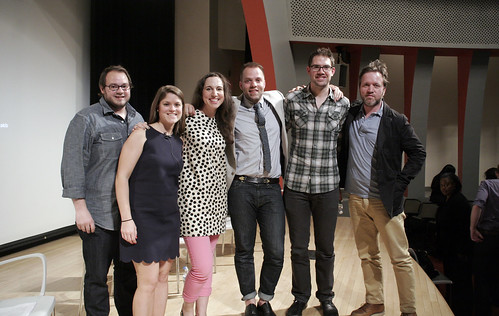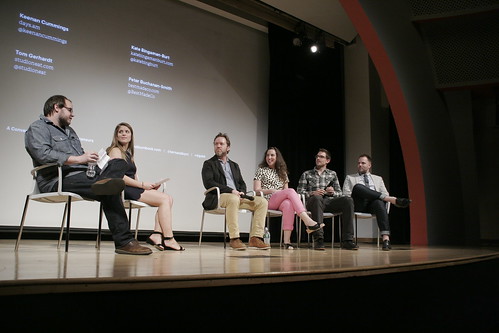
I’m so behind, but I’ll try to write a little something anyway, for my own memory’s sake. (Note, some of this is from my post written for the AIGA/NY blog)
So last Thursday, I went to an event called Kern & Bern: Conversation With Design Entrepreneurs hosted by co-authors Tim Hoover and Jessica Heltzel who led a four-person panel of current design entrepreneurs who have made careers around their varied interests, passions, and backgrounds.The Kern & Burn project started as a series of highlights from Hoover & Heltzel’s interviewers with various designers and eventually evolved into their kickstarter-funded book featuring 30 in-depth interviews with design entrepreneurs. I wanted to get the book, I should have gotten the book, but it was $30 and I didn’t get it. One day. When I’m famous.
On the panel was (from right to left):
- Peter Bucanan-Smith, who founded Best Made Company, a company who’s first product was high-end axes and now creates high-end ourdoor gear. He used to work a designer until he decided to sell axes instead
- Kate Bingaman-Burt, a professor at Portland State University and professional illustrator. She makes really fun and playful illustrations, I like them
- Tom Gerhardt, co-founder of Studio Neat, a company that has successfully started a number of crowd-funded commercial projects after creating Glif through Kickstarter
- Keenan Cummings, creative director of Wander, an upcoming location app, and Days, a creative visual diary app.
One of my favorite points they talked about was starting, promoting, and committing to your side projects. Designers (or any artist) should feel comfortable dedicating their time to pet projects and showcasing them publicly. The panelists, Bingaman-Burt & Cummings especially, argued that designers should actually lead with their personal projects during presentations rather than the work they think will be the most impressive. Bingaman-Burt explained that “it’s demonstrating you have a point of view, that you have things to say…” She also made a point that I liked as a person who is terrible at small talk: by leading with your personal projects you’re talking about the projects you know the most intimately and that are the most important to you so you’ll be more inclined talk about it with excitement and authority—You’ll make a better impression and are more likely to form connection with whoever your’e speaking with. I’ve found that at interviews I get asked what my favorite project I’ve worked on is and I feel lucky that I readily have an answer for it. This is also why I made my last Friday 5 a list of my “side projects” (or whatever they are).
“At some point I realized I could have gigantic budgets, an amazing team, and produce the glossiest work, but I’d rather have it be a little crappier and be mine,” explained Cummings.
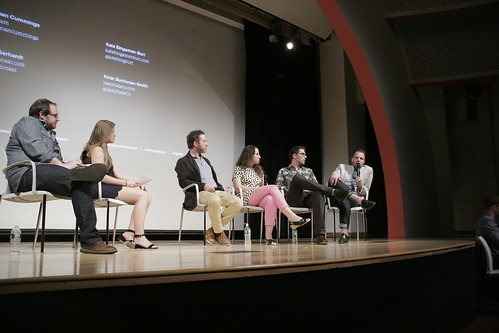
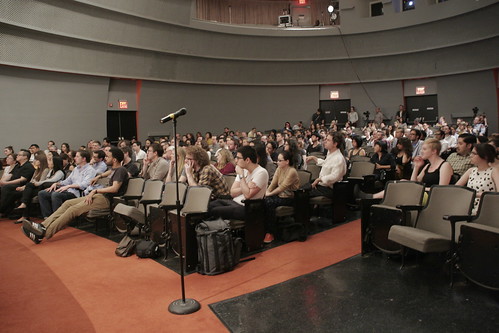
The panelist admit that it can be difficult for people to “do what they love” when many designers might still be figuring out what it is they’re passionate about or they might think they love something only to realize they don’t. Or they might think they love everything and can’t choose. It’s ok to be unsure of what you want to do, they said. I was really glad to hear this. For a while in college I felt this way and I felt like I was surrounded by my very talented friends who knew exactly what they wanted to be doing and moved towards their goals with every glowing, golding, glorious fiber of their beings. I feel like I’m on the right track now, but it was reassuring to know that it’s a common problem (it was also annoying to be reminded none of the personally significant feelings I feel are unique). Bucanan-Smith said this about his own experience: “For me in particular it’s been a life time of starts and stops and repeated failures. But each one has informed the next and it’s been very important for me not to get too hung up on when it doesn’t work out and just to move on to the next thing.” He recommended that designers should try focusing on that inkling of what they think they might love, have faith that it’s worth doing, and that other people will appreciate it.

Once finding that passion, another hurdle can be getting started and to keep going. Gerhardt encouraged people to take advantage of the connectivity technology affords. Whatever project you want to do, however strange you might think it is, it’s more than likely you’ll find a good number of people who like it too and are willing to support you. Since Gerhardt has had three of his projects funded by Kickstarter, he appreciates the boost of motivation that making your ideas public can give you, he even admitted that when his second project hit roadblocks it was because of his Kickstarter backers that he ended up completing the project, which he would have given up otherwise. I totally believe in this because I would have 100% given up on this very blog, which is…I think three years old now (!) if it wasn’t for the little WordPress analytics graphs that show how many people check it each day.
For Bucanan-Smith giving himself deadlines ended up being an enormous blessing and became the rhythm to his work: “to have momentum is the most powerful thing that any entrepreneur can have. Without it I think you’re just dead.” Another valid point. I live & breathe deadlines.
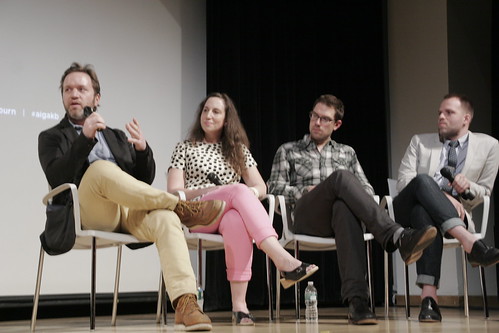
In one of the ending discussions, the group shared their thoughts on whether they believed being an entrepreneur was something inherent in a person or a set of skills that could be learned. As a teacher, Bingaman-Burt observed that some students would immediately take to initiating their own entrepreneurial projects and “get the bug,” while others would simply be fulfilling the requirements. It’s ok, she felt, not to be an entrepreneur and not to want to be one, but she did feel that was important to get exposure to the experience of putting spreading yourself out into all the different jobs that an entrepreneur must tackle. Bucanan-Smith put it this way:
“Who’s to say if you’re cut out for it or not? If you have a conviction–if you have something inside of you–then I feel like you need to exercise that. The crime is not failed business, it’s that you went around your whole life talking to your friends about this crazy business idea you had and never did it. Now that is a true failure.”
